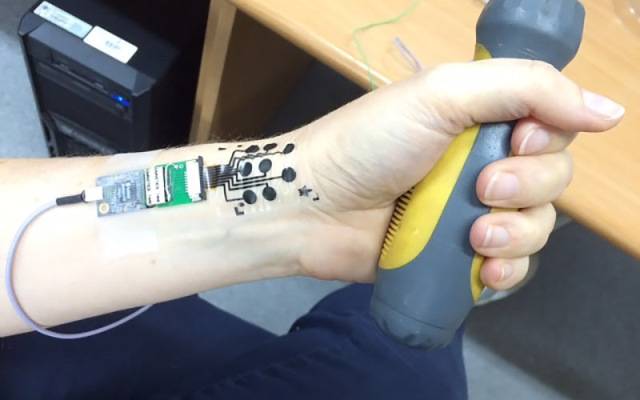A new medical innovation, developed at Tel Aviv University, uses ‘stick it and forget it’ skin electrodes affixed to the skin, just like a child’s temporary tattoo, and is able to monitor muscle activity which discloses emotions.
The innovation is meant to replace the somewhat unpleasant medical procedure of electromyography – recording electrical signals through the skin.
A novel skin electrode, recently developed at TAU’s Center for Nanoscience & Nanotechnology, now takes this procedure out of the laboratory, doing away with the cold, sticky gel used to enhance conductivity. The friendly new electrode is comfortable and accessible, allowing users to carry on as usual with their daily routines, while monitoring their muscle activity for many hours, for a range of medical and other purposes.
The study, led by Prof. Yael Hanein, Head of TAU’s Center for Nanoscience & Nanotechnology, was conducted within the framework of an EU project, and partly supported by the BSMT Consortium of Israel’s Ministry of Economy.
Wide Range of Applications
The electrodes can be used in a wide range of medical tests, from mapping emotions to moving artificial limbs.
“The ability to identify and map people’s emotions has many potential uses,” says Prof. Hanein. “Advertisers, pollsters, media professionals and others – all want to test people’s reactions to various products and situations. Today, with no accurate scientific tools available, they rely mostly on inevitably subjective questionnaires. To address this need, researchers worldwide are trying to develop methods for mapping emotions by analyzing facial expressions, mostly via facial photos and smart software. Our skin electrode provides a simple, convenient solution: monitoring expressions and emotions based on the electric signals received from facial muscles.”
Hanein says this is only the beginning.
The new skin electrode has many more potential applications. A study initiated recently in collaboration with researchers at the Tel Aviv Medical Center uses it to monitor the muscle activity of patients with neurodegenerative diseases; physiological data measured in specific muscles may be used in the future to indicate the alertness of drivers on the road; patients in rehabilitation following stroke or brain injury may utilize the ‘tattoo’ to improve muscle control; and amputees may employ it to move artificial limbs with remaining muscles.
A Nanotechnology Tattoo
The highly promising new skin electrode is based on a surprising fusion of nanotechnology with a very basic and commonplace product: the temporary tattoos that children love so much.
“We used readily available materials and conventional industrial printing techniques, in order to simplify and speed up the development process,” says Hanein. “Our ‘electric tattoo’ consists of three parts: a carbon electrode, an adhesive surface that sticks temporary tattoos to the skin and a nanotechnology-based conductive polymer coating, with special nano-topography, that enhances the electrode’s performance. The result is an efficient skin electrode that records a strong and steady signal for many hours, and does not irritate the skin. The user just fixes it onto the skin at the right spot and forgets about it, then carries on as usual while the little ‘tattoo’ measures and records muscle activity.”
By: United with Israel Staff
